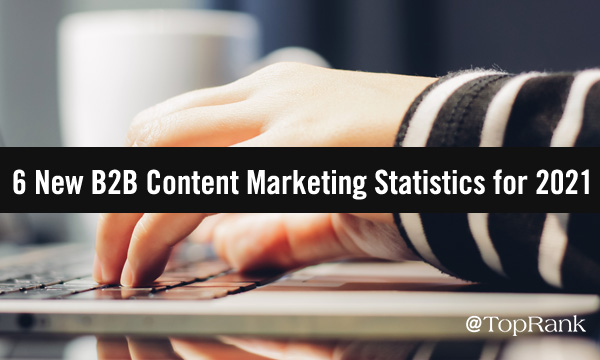
 “You can come up with statistics to prove anything, Kent. Forty percent of all people know that.” - Homer Simpson Homer might be right, generally speaking. But I still maintain that good, accurate, timely statistics from trusted sources can serve as vital guideposts and benchmarking tools, especially when it comes to business strategy. This certainly applies in my own corner of the business world: the fast-changing and critically important field of B2B content marketing. Trends in content marketing tend to reflect broader truths, since we’re talking about the ways in which companies and customers interact and communicate. Because of this, I like to keep a close eye on new research and data as it surfaces, filing away nuggets that strike me as especially telling. Today, I’ll share six new B2B content marketing statistics that everyone should know.
“You can come up with statistics to prove anything, Kent. Forty percent of all people know that.” - Homer Simpson Homer might be right, generally speaking. But I still maintain that good, accurate, timely statistics from trusted sources can serve as vital guideposts and benchmarking tools, especially when it comes to business strategy. This certainly applies in my own corner of the business world: the fast-changing and critically important field of B2B content marketing. Trends in content marketing tend to reflect broader truths, since we’re talking about the ways in which companies and customers interact and communicate. Because of this, I like to keep a close eye on new research and data as it surfaces, filing away nuggets that strike me as especially telling. Today, I’ll share six new B2B content marketing statistics that everyone should know.
6 Eye-Opening B2B Content Marketing Statistics for 2021
These stats highlight many of the challenges, opportunities, and changes unfolding here in 2021. #1: Businesses are the most trusted institution for information in 2021. (Source: Edelman) Edelman’s 2021 Trust Barometer shows that the business sector has risen above government, media, and NGOs in its Trust Index. Edelman also found that business is now seen as the institution that is both competent and ethical.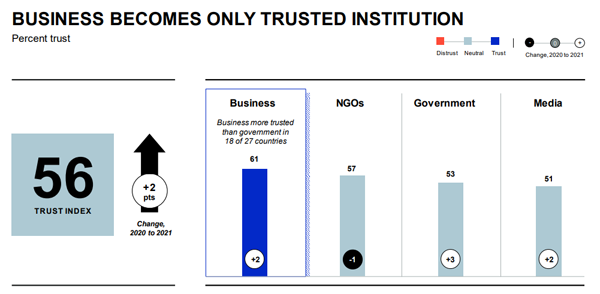 Needless to say, this is a big moment for content marketers. Distrust is running rampant among misinformation, uncertainty and anxiety across the globe. People are looking to businesses for credible, clear, and accurate insights and guidance. As marketers, we must harness this opportunity to earn and solidify this trust. How can we best do so? Edelman’s survey results point to a clear answer: by vigorously guarding information quality and filtering out the noise.
Needless to say, this is a big moment for content marketers. Distrust is running rampant among misinformation, uncertainty and anxiety across the globe. People are looking to businesses for credible, clear, and accurate insights and guidance. As marketers, we must harness this opportunity to earn and solidify this trust. How can we best do so? Edelman’s survey results point to a clear answer: by vigorously guarding information quality and filtering out the noise. 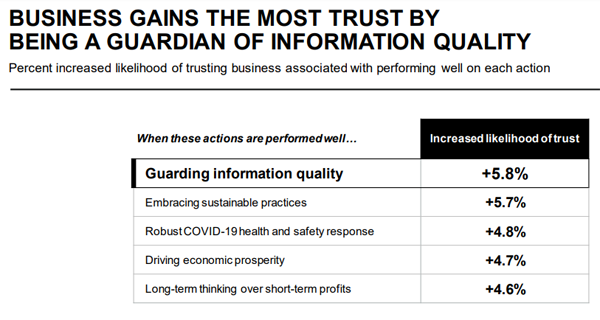 [bctt tweet="“People are looking to businesses for credible, clear, and accurate insights and guidance. As marketers, we must harness this opportunity to earn and solidify this trust.” — Nick Nelson @NickNelsonMN" username="toprank"] #2: 88% of marketers say collecting first-party data is a priority in 2021. (Source: Merkle) This comes from Merkle’s 2021 Customer Engagement Report, highlighting a key frontier for informing content strategies this year. While third-party data and insights like those we’ve aggregated here are useful, nothing can quite match the relevance and impact of information drawn from your own customers and digital experiences. Heightening data privacy regulations are playing a major role in motivating these initiatives, according to Merkle’s research. The report also points to a rise in “zero-party data,” which includes "transaction intentions, preference data, personal context, and what the customer thinks about the company." Per Merkle: "Marketers don't have to infer customer preferences or behavior through secondary behavior but are instead explicitly told, straight from the source. The best zero-party data is when the customers trust the brand and are willing to volunteer their data with the understanding that it will improve their experience." #3: Mobile device usage rose dramatically in 2020. (Souce: App Annie) Surely this comes as no surprise. Deprived of the ability to congregate in person, many of us increased our reliance on different forms of connection and entertainment. App Annie’s State of Mobile 2021 report found that mobile adoption saw two-to-three years worth of advancement in 12 months during 2020, with mobile time surpassing live TV. Substantial increases were seen across the board globally:
[bctt tweet="“People are looking to businesses for credible, clear, and accurate insights and guidance. As marketers, we must harness this opportunity to earn and solidify this trust.” — Nick Nelson @NickNelsonMN" username="toprank"] #2: 88% of marketers say collecting first-party data is a priority in 2021. (Source: Merkle) This comes from Merkle’s 2021 Customer Engagement Report, highlighting a key frontier for informing content strategies this year. While third-party data and insights like those we’ve aggregated here are useful, nothing can quite match the relevance and impact of information drawn from your own customers and digital experiences. Heightening data privacy regulations are playing a major role in motivating these initiatives, according to Merkle’s research. The report also points to a rise in “zero-party data,” which includes "transaction intentions, preference data, personal context, and what the customer thinks about the company." Per Merkle: "Marketers don't have to infer customer preferences or behavior through secondary behavior but are instead explicitly told, straight from the source. The best zero-party data is when the customers trust the brand and are willing to volunteer their data with the understanding that it will improve their experience." #3: Mobile device usage rose dramatically in 2020. (Souce: App Annie) Surely this comes as no surprise. Deprived of the ability to congregate in person, many of us increased our reliance on different forms of connection and entertainment. App Annie’s State of Mobile 2021 report found that mobile adoption saw two-to-three years worth of advancement in 12 months during 2020, with mobile time surpassing live TV. Substantial increases were seen across the board globally: 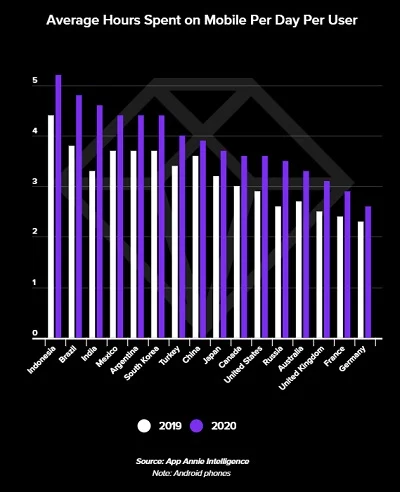 App Annie also shared data around the most-used social networking apps in 2020. No. 1 on the list may surprise you:
App Annie also shared data around the most-used social networking apps in 2020. No. 1 on the list may surprise you:
- TikTok
- WhatsApp Messenger
- Facebook Messenger
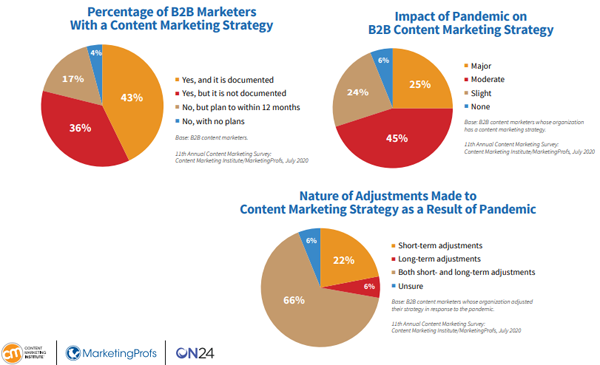 When asked specifically about the most common changes made in response to COVID-19, these were the top responses from B2B marketers:
When asked specifically about the most common changes made in response to COVID-19, these were the top responses from B2B marketers:
- Changed targeting/messaging strategy (70%)
- Adjusted editorial calendar (64%)
- Changed content distribution/promotion strategy (53%)
- Changed website (40%)
- Put more resources toward social media/online communities (40%)
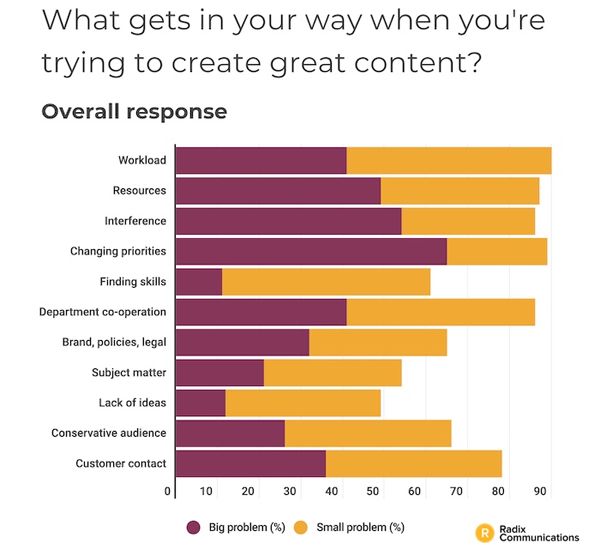 Another finding in Radix’s research: “B2B marketers who can’t talk to customers are 27% less likely to be happy with their content’s business results.” This ties back to the prioritization of first-party data and gathering direct insight from the audience.
Another finding in Radix’s research: “B2B marketers who can’t talk to customers are 27% less likely to be happy with their content’s business results.” This ties back to the prioritization of first-party data and gathering direct insight from the audience.
B2B Content Marketing by the Numbers
Homer Simpson wasn’t entirely off base. People can dig up statistics to make almost any type of case. But here, the numbers only confirm trends and realities that most B2B content marketers are already experiencing. Trust hangs in the balance; data is growing both more important and more nuanced; mobile and social media usage have exploded; and evolving priorities create new challenges for planning. We hope that the context provided by these B2B content marketing statistics helps you as you find your way in the new landscape. For more forward-looking insight to guide your strategy, check out Lee Odden’s post on the Top B2B Marketing Trends for 2021.The post 6 Eye-Opening B2B Content Marketing Statistics for 2021 appeared first on B2B Marketing Blog - TopRank®.
from B2B Marketing Blog – TopRank® https://ift.tt/3aqQm4M
via IFTTT
No comments:
Post a Comment